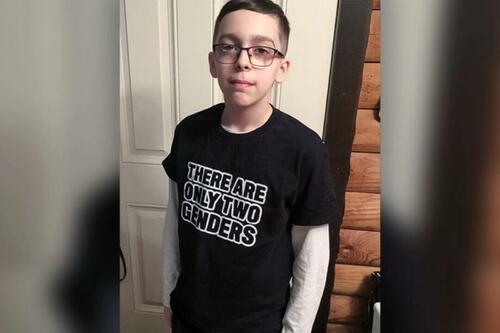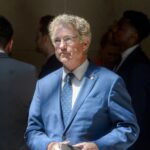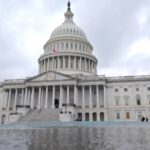
Authored by Zachary Stieber via The Epoch Times (emphasis ours),
A U.S. appeals court on June 9 upheld a ban preventing a Massachusetts middle school student from wearing a shirt reading “There are only two genders.”
Another prohibition by school administrators, this time blocking the same student from wearing the shirt with “only two” covered by tape, on which was written “censored,” is also allowed under court precedent, according to the ruling by the U.S. Court of Appeals for the First Circuit.
“The question here is not whether the t-shirts should have been barred. The question is who should decide whether to bar them—educators or federal judges. Based on Tinker, the cases applying it, and the specific record here, we cannot say that in this instance the Constitution assigns the sensitive (and potentially consequential) judgment about what would make ‘an environment conducive to learning’ at NMS to us rather than to the educators closest to the scene,” U.S. Circuit Judge David Barron wrote for a unanimous panel of the court.
In Tinker v. Des Moines Independent Community School District, the U.S. Supreme Court in 1969 ruled that a ban on students wearing armbands in protest against the Vietnam War violated the students’ First Amendment rights.
U.S. District Judge Indira Talwani cited the ruling when in 2023 she ruled in favor of the administrators at the John T. Nichols Middle School (NMS) and Middleborough School District in Massachusetts against Liam Morrison (L.M.), the boy who wore the “two genders” shirt to school.
“[The school] permissibly concluded that the shirt invades the rights of others,” Judge Talwani said before quoting Tinker. “Schools can prohibit speech that is in ‘collision with the rights of others to be secure and be let alone.’”
The NMS dress code states in part that students must not wear pieces of clothing that “state, imply, or depict hate speech or imagery that [targets] groups based on race, ethnicity, gender, sexual orientation, gender identity, religious affiliation, or any other classification.”
Liam was removed from class after a teacher raised concerns about his shirt. He was ultimately sent home after he declined to remove the shirt, and his father said he would not force the removal.
When Liam went to school on another day with the shirt partially covered in tape, administrators told him to take it off, and he did.
Lawyers for Liam argued that the shirts did not impinge on the rights of other students. The shirts “like the Tinker children’s armbands, constitute ‘a silent, passive expression of opinion,’” they wrote in a brief to the appeals court.
“The school banned L.M.’s t-shirts based on a few subjective complaints that students felt upset, unsafe, or targeted,” they said. “But Tinker bars schools from censuring expression based on the ‘discomfort’ or ‘fear’ that results from exposure to ‘unpopular [viewpoints].’”
In a related ruling from the U.S. Court of Appeals for the Third Circuit, the court ruled that a school district could not bar speech about “contentious issues” such as “racial customs,” “religious tradition,” or “sexual orientation” without a “particularized reason as to why it anticipates substantial disruption.”
The First Circuit panel stated on June 10 that even if the shirts did not invade the rights of others, administrators reasonably forecast that they would disrupt learning.
Administrators said the message on the shirt would “materially disrupt transgender and gender non-conforming students’ ability to focus on learning while in a classroom where the message is being displayed.” The court agreed, because of “the demeaning nature of the message” and how administrators attested to knowing of some students who identify as transgender struggling with suicidal thoughts.
“In such circumstances, we think it was reasonable for Middleborough to forecast that a message displayed throughout the school day denying the existence of the gender identities of transgender and gender non-conforming students would have a serious negative impact on those students’ ability to concentrate on their classroom work,” wrote Judge Barron, who was joined by U.S. Circuit Judges O. Rogeriee Thompson and Lara Montecalvo.
Judges Barron, Thompson, and Talwani were appointed by President Barack Obama. Judge Montecalvo was appointed by President Joe Biden.
David Cortman, vice president of U.S. litigation for the Alliance Defending Freedom, which is representing Liam, told The Epoch Times in an email that “our legal system is built on the truth that the government cannot silence any speaker just because it disapproves of what they say.”
He said the First Circuit erred in its decision and that the group was reviewing all legal options, including an appeal.
A lawyer for the school and school district did not return an inquiry.
Authored by Zachary Stieber via The Epoch Times (emphasis ours),
A U.S. appeals court on June 9 upheld a ban preventing a Massachusetts middle school student from wearing a shirt reading “There are only two genders.”
Another prohibition by school administrators, this time blocking the same student from wearing the shirt with “only two” covered by tape, on which was written “censored,” is also allowed under court precedent, according to the ruling by the U.S. Court of Appeals for the First Circuit.
“The question here is not whether the t-shirts should have been barred. The question is who should decide whether to bar them—educators or federal judges. Based on Tinker, the cases applying it, and the specific record here, we cannot say that in this instance the Constitution assigns the sensitive (and potentially consequential) judgment about what would make ‘an environment conducive to learning’ at NMS to us rather than to the educators closest to the scene,” U.S. Circuit Judge David Barron wrote for a unanimous panel of the court.
In Tinker v. Des Moines Independent Community School District, the U.S. Supreme Court in 1969 ruled that a ban on students wearing armbands in protest against the Vietnam War violated the students’ First Amendment rights.
U.S. District Judge Indira Talwani cited the ruling when in 2023 she ruled in favor of the administrators at the John T. Nichols Middle School (NMS) and Middleborough School District in Massachusetts against Liam Morrison (L.M.), the boy who wore the “two genders” shirt to school.
“[The school] permissibly concluded that the shirt invades the rights of others,” Judge Talwani said before quoting Tinker. “Schools can prohibit speech that is in ‘collision with the rights of others to be secure and be let alone.’”
The NMS dress code states in part that students must not wear pieces of clothing that “state, imply, or depict hate speech or imagery that [targets] groups based on race, ethnicity, gender, sexual orientation, gender identity, religious affiliation, or any other classification.”
Liam was removed from class after a teacher raised concerns about his shirt. He was ultimately sent home after he declined to remove the shirt, and his father said he would not force the removal.
When Liam went to school on another day with the shirt partially covered in tape, administrators told him to take it off, and he did.
Lawyers for Liam argued that the shirts did not impinge on the rights of other students. The shirts “like the Tinker children’s armbands, constitute ‘a silent, passive expression of opinion,’” they wrote in a brief to the appeals court.
“The school banned L.M.’s t-shirts based on a few subjective complaints that students felt upset, unsafe, or targeted,” they said. “But Tinker bars schools from censuring expression based on the ‘discomfort’ or ‘fear’ that results from exposure to ‘unpopular [viewpoints].’”
In a related ruling from the U.S. Court of Appeals for the Third Circuit, the court ruled that a school district could not bar speech about “contentious issues” such as “racial customs,” “religious tradition,” or “sexual orientation” without a “particularized reason as to why it anticipates substantial disruption.”
The First Circuit panel stated on June 10 that even if the shirts did not invade the rights of others, administrators reasonably forecast that they would disrupt learning.
Administrators said the message on the shirt would “materially disrupt transgender and gender non-conforming students’ ability to focus on learning while in a classroom where the message is being displayed.” The court agreed, because of “the demeaning nature of the message” and how administrators attested to knowing of some students who identify as transgender struggling with suicidal thoughts.
“In such circumstances, we think it was reasonable for Middleborough to forecast that a message displayed throughout the school day denying the existence of the gender identities of transgender and gender non-conforming students would have a serious negative impact on those students’ ability to concentrate on their classroom work,” wrote Judge Barron, who was joined by U.S. Circuit Judges O. Rogeriee Thompson and Lara Montecalvo.
Judges Barron, Thompson, and Talwani were appointed by President Barack Obama. Judge Montecalvo was appointed by President Joe Biden.
David Cortman, vice president of U.S. litigation for the Alliance Defending Freedom, which is representing Liam, told The Epoch Times in an email that “our legal system is built on the truth that the government cannot silence any speaker just because it disapproves of what they say.”
He said the First Circuit erred in its decision and that the group was reviewing all legal options, including an appeal.
A lawyer for the school and school district did not return an inquiry.
Loading…






